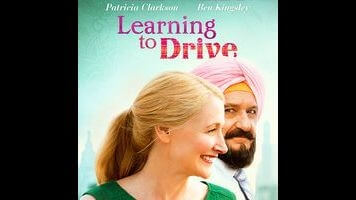Learning To Drive means learning to live, says this sappy Patricia Clarkson vehicle
Film Reviews Film
Early in Isabel Coixet’s latest feature, Learning To Drive, an exchange between the protagonists pokes ever-so-mildly at one of the film’s central issues. The morning after brittle book critic Wendy (Patricia Clarkson) is summarily dumped by her husband of 21 years, the sympathetic NYC cab driver who drove her home shows up on her doorstep with a package she left in his cab. She tries to pay him, but he demurs, saying he just likes to help people. “That’s impossible,” she mutters. “You can’t be from New York.”
Like so much of the film, this punchline is toothless, amiable, and bland. At most, it’s meant to prompt nods and knowing chuckles from people who have never been to New York, but feel like they know the place from Seinfeld and Woody Allen comedies. But while it’s a softball gag, it suggests a hardball question. The cabbie, Darwan (Ben Kingsley), is a Sikh political refugee estranged from his native India. He lives in a small apartment crowded with illegal-immigrant friends scrambling to get by in a crowded, competitive city. His nephew is going native and abandoning tradition. And his sister is pressuring him to accept an arranged marriage with a stranger. Why is Darwan so devoted, in this moment and throughout the film, to helping a fragile, snappish, overprivileged white lady fix her life? The kindest answer is, “Because selling cross-cultural friendships as infinitely supportive and selfless might help culturally cloistered people accept them.” A less-kind answer is that Darwan represents an old, familiar wish-fulfillment stereotype of the brown-skinned person who exists to help white-skinned people self-actualize. New Yorker or not, it’s a relief when cracks in his saintly reserve finally emerge, letting him express a few needs of his own.
Learning To Drive leans heavily on its central/titular metaphor: Wendy has always relied on public transport and her husband to get her around, but after a long struggle with denial over the divorce, she promises to the needed steps to visit her adult daughter (Grace Gummer) in Vermont. Darwan’s day job as a driving instructor brings them back together, and prompts many, many scenes of him dispensing driving advice that’s suspiciously applicable outside of a car. “The driver’s biggest problem is everyone else,” he tells Wendy during one lesson. “You can’t always trust people to behave properly.” Later, he tells her parallel parking is like cooking, and that she needs to “taste” her surroundings to make decisions by careful stages. The point, made clumsily and delivered often, is that driving is just life writ small: Wendy needs to pay attention to her surroundings, navigate the world with less fear and anger, get outside her safety zone, and so forth.
But Learning To Drive is too focused on the literal road while teasing at the metaphorical one. When the film bogs down in the question of whether Wendy will pass her driving test, or successfully cross a (certainly symbolic, but also real) bridge, it starts to feel like a retread of Tom McCarthy’s The Visitor, if every other scene in that film had been about the nuts and bolts of paradiddles and Richard Jenkins’ daily practice sessions. And much of the non-driving material feels calculated to try to reach specific demographics. A few genteel moments of raunch, as Wendy reads The Joy Of Sex out loud as though it’s a mildly regrettable checklist, or discusses blowjobs with a giggle and a wink, particularly feel like nods to the Bridesmaids generation, and an abortive attempt to take the film out of “safe Christmas gift for grandma” territory. When the story finally shifts to follow Darwan and his new wife (Homeland’s Sarita Choudhury), it at least feels slightly less like Driving Miss Wendy, but the script doesn’t do enough to show what Darwan gets from Wendy, apart from an ideal he doesn’t see in his own marriage.
Coixet, Kingsley, and Clarkson last teamed on Coixet’s 2008 drama Elegy, which coincidentally flipped the script seen here: In that Philip Roth adaptation, Kingsley plays a critic, and Clarkson his former student turned lover. That film has its Rothian flaws, most noticeably the tired old business of the aging, Roth-like mentor beset by a string of beautiful ladies who revitalize him with their sexual admiration and devotion. But at least Elegy has some passion. Learning To Drive has harmless sweetness, many revealing speeches about life, and a Kingsley performance that shades strongly into a “Robin Williams as a straight-faced foreigner” routine. It has the intelligence to answer its own questions, about how a New Yorker could be so endlessly selfless. It just doesn’t have the courage of its convictions, to delve a little deeper past the broad strokes of this frustratingly familiar immigrant-saves-native story.